Abstract Algebra
1/100
Earn XP
Name | Mastery | Learn | Test | Matching | Spaced |
|---|
No study sessions yet.
101 Terms
Group Homomorphism
A map between two groups (designated phi) that respects the group operation by fulfilling the following property
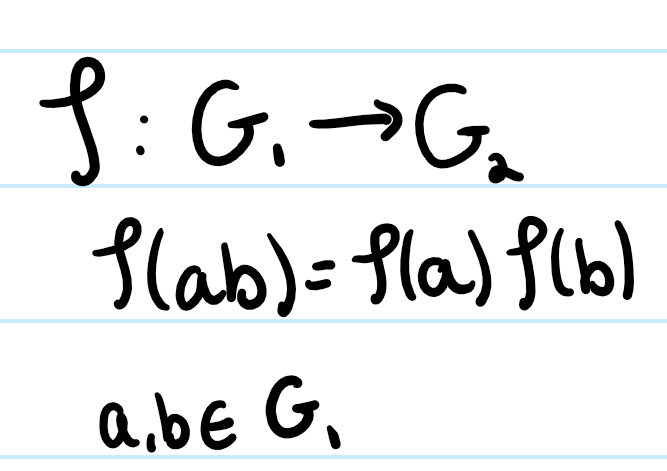
Group Isomorphism
A bijective group homomorphism. Every element in one group can be assigned to an unique element in the other group and the structure of the two groups are the same. The Cayley diagram of one group should match the Cayley diagram of the other group so that the points are just relabeled.
Cosets
A set that can be computed by composing every element of a subgroup by an element in the group. Right cosets are found by composing the new element on the right of the subgroup and left cosets are found by composing the new element on the left of the subgroup.
Subgroup
A subset of another group that also forms a group. All elements in the subset must also be elements of the group, the subset must contain the neutral element, every element in the subset must have its inverse in the subset, composing two elements in the subset produces another element in the subset (closure).
Normal Subgroup
A subgroup whose left and right cosets are equivalent.
Center
Z(G); The set of elements in a group that commute with all elements in a group.

Automorphism
An isomorphism from a group to itself. Can be found by mapping generators of the group to all other generators of the group.
Abelian
Another term for commutative
Commutative
a*b=b*a
Associative
a*(b*c)=(a*b)*c
Kernel
The preimage of e2 in G1. All the elements in G1 that map to the identity in G2. The kernel always forms a subgroup in G1. It is often denoted by the letter K.
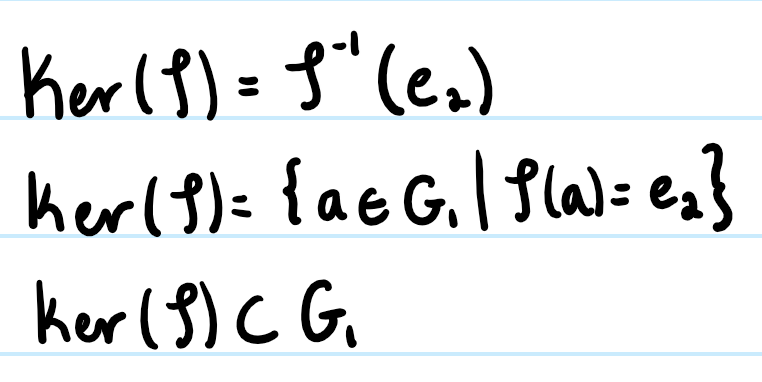
Conjugated
Two elements, a and b in G, are conjugated if there exists an element c in G, such that ac=cb or a=cbc-1. Conjugation defines an equivalence relation: x~y iff x=zyz-1 for some z in G.
Cyclic
A group is considered to be cyclic if all the elements in the group can be generated by a single element. All subgroups of a cyclic group are cyclic. All cyclic groups are isomorphic to Zn where n is the number of elements in, or the order of, the cyclic group in question.
Equivalence Relation
An equivalence relations relates two elements in a set, a and b, written as a~b, and fulfills the following properties: Reflexivity, Symmetry, and Transitivity. Every equivalence relation determines a partition of a set.
Partition
All elements of a set are included in a single grouping and no elements can appear in multiple groupings. A partition is also known as a disjoint union of a set.
Reflexivity
a~a (or a=a depending on notation)
Transitivity
If a~b and b~c, then a~c
Equivalence Class
In a group, a subset of elements that are all equivalent to each other based on a given equivalence relation.
Group Action
A group homomorphism from a group G on a set X. It is generally denoted rah. Every element in the set is mapped to another element in X. Essentially the group maps the set X to permutations of X.

Orbit
The orbit (x) is all of the elements that x can be mapped to in the set using the group operation. All of the potential images of x in the set. A subset of X.

Stabilizer
The stabilizer of x is all of the elements in G that map x to itself using the group operation (or group action). The stabilizer is a subgroup of G.

Orbit-Stabilizer Theorem
For any group action, the Order of G is equal to the order of the stabilizer of a particular element multiplied by the order of the orbit for that same element.

Innerautomorphisms
A special type of automorphism that is given by the conjugation action. Innerautomorphisms map elements within their conjugacy classes.
Cayley Table
Describes the structure of a finite group by arranging all possible products of all the group’s elements in a table similar to that of an addition or multiplication table. A Cayley table is able to tell us if the group is abelian, the inverses of each element, and the center.
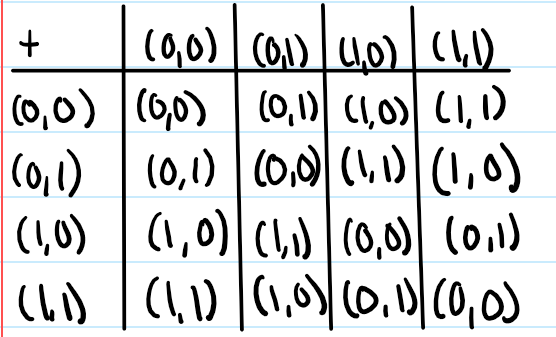
Cayley Diagram
Also known as a Cayley graph. It encodes the abstract structure of a group. It uses a specified set of generators for the group.
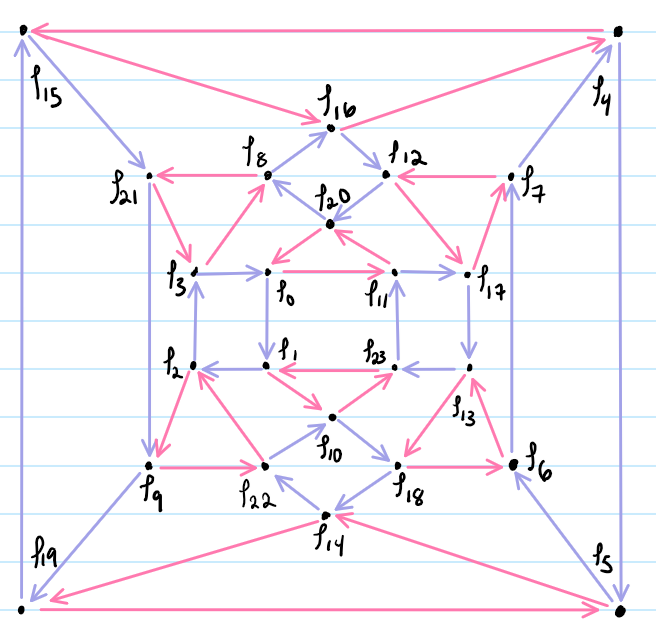
Unit
In a ring, a unit is an element with a multiplicative inverse
Lattice of Subgroups
A vertical diagram of all subgroups of a group that shows the structure of the subgroups, i.e. which subgroups are a subgroup of other subgroups.
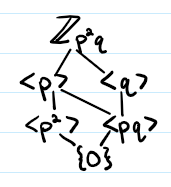
Lagrange’s Theorem
For any finite group, G, the order of a subgroup of G, H, divides the order of G
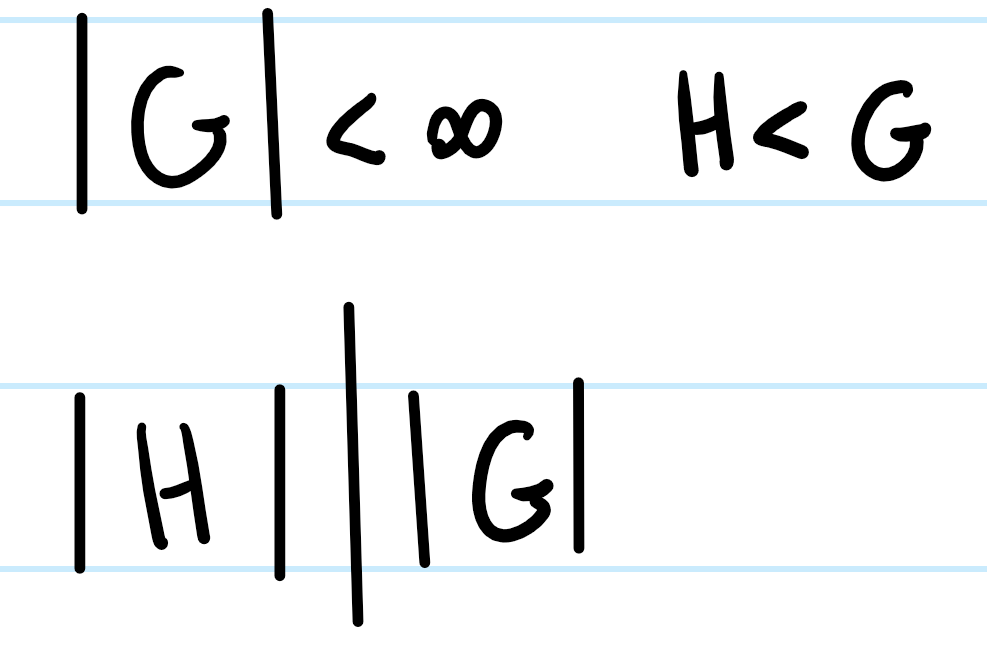
Permutation
Let X be a set. A permutation of X is a bijection f: X → X. All of the ways to arrange the set.
Order of Permutations
The least common multiple of the order of each disjoint cycles.
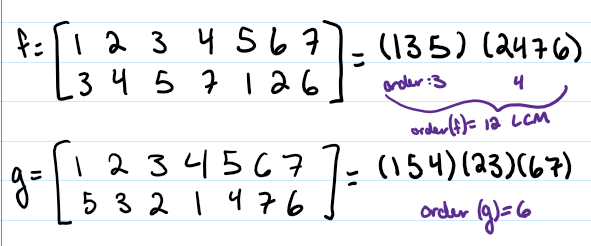
Even Permutations
If the permutation can be written as an even number of transitions, it is an even permutation.
Odd Permutations
If the permutation can be written as an odd number of transpositions, it is an odd permutation.
Transposition
Also known as a disorder. A 2 cycle. A permutation of only two elements. Every permutation can be written as a product of transpositions.

Prove the following implication.
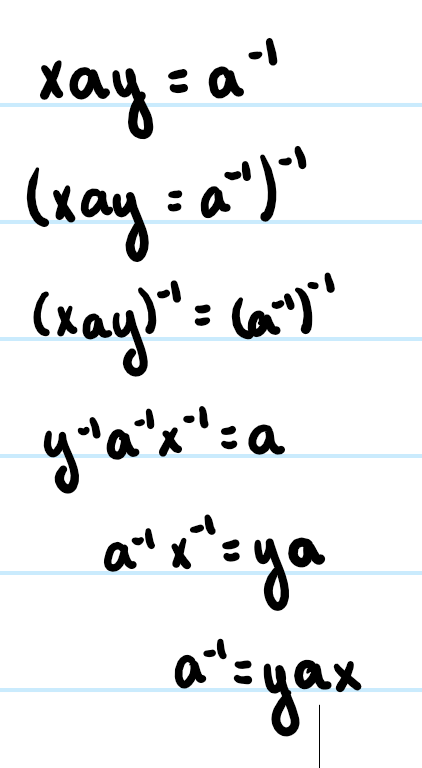

Prove the following implication.
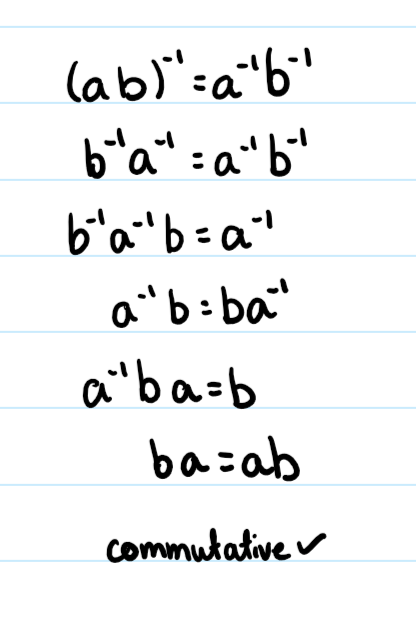
Quotient Group
Also known as a factor group. A group whose elements are equivalence classes that is found by moding out by a normal subgroup. It is the set of cosets of the subgroup that you mod out by.
Symmetry
If a~b, then b~a
Well Defined
When working with an operation of equivalence classes, the operation is “well-defined” if it does not matter which representative that we choose from the equivalence class. I.e., when adding fractions, it is well defined because we can replace ½ with 3/6 and the result is equivalent.
Centralizer
The set of elements in a group which commute with all elements in the group. It is a subgroup of G.

Normalizer
The set of elements in a group that permute with a particular subset.

Subring
A subset of a ring with the same two binary operations that fulfills all of the requirements to be a ring.
Ideal
A subring, I, of a ring, R, where multiplying any element in the subring by an element in the ring produces an element in the subring. When multiplication is commutative, it is a two-sided ideal. Otherwise, you have right ideals and left ideals.
Distributive Property
a(b+c) =ab+ac
Field
A commutative ring with unity in which there are no non-zero zero divisors. This means that every element, excluding zero, has a multiplicative inverse.
Integral Domain
A commutative ring in which there are no non-zero zero divisors.
Quotient Ring
Similar to a quotient group, it is a ring whose elements are equivalence classes that is found by moding out by an ideal.
Linear Comination
An expression constructed from a set of terms by multiplying each term by a constant and adding the results. An example is a1v1+a2v2+…+anvn
Ring Homomorphism
Similar to a group homomorphism but working with rings.

Kernel of Ring
Similar to the kernel of a group. All the elements in R1 that map to the additive identify in R2

Principal Ideal
An ideal that can be generated by a single element
Irreducible
An element q is irreducible if it is non-zero and not a unit and fulfills the following property: if q=a * b, then either a is a unit or b is a unit

Prime
An element p is prime if p is non-zero and not a unit and fulfills the following property: if p divides ab, then p divides a or p divides b
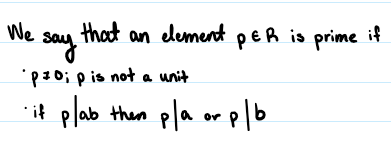
Euclidean Domain
A ring in which the Euclidean algorithm holds. A subset of integral domains in which we can do long division. There must exist a “size” function to determine if one element is “smaller” than another (absolute value in integers, order of polynomials)
Euclidean Algorithm
The process to determine the GCD of two elements.
Maximal Ideal
An ideal in which there is no other ideals that can be squeezed between the ideal and the ring. Maximal ideals are generated by an irreducible element.

Prime Ideal
An ideal in which every element of the ideal is prime.

Characteristic of a Ring
In a ring with unity, the characteristic of the ring is the number of times that the multiplicative identity is added to itself to produce the additive neutral.

Rational Root Theorem
For any polynomial p(x) with integer coefficients, p(x)=akxk+…a1x+a0 and q=n/m is a rational number and a root of p(x), then m divides ak and n divides a0
Field Expansion
Adding additional values to a field by solving a polynomial equation that does not have a rational root by moding out by an irreducible polynomial.

“is an element of”


When related to subgroups
“is a normal subgroup of”


When related to rings
“is a two-sided ideal of”

When related to groups
“is a subgroup of”


When related to rings
“is a subring of”

“is a subset of”


The set of all integers; {…,-2, -1, 0, 1, 2, …}

The set of all rational numbers; the set of all elements that can be written as the ratio of two integers, a set of equivalence classes

The set of all natural numbers; normally {1, 2, 3, …} but Anton includes 0

The set of all complex numbers; any real number can be written as a complex number with the “i” term having a coefficient of 0

“for any”/”for all”/”for every”

“there exists”
s.t.
“such that”
w.r.t.
“with respect to”

The group of integers under addition mod n

The set of all possible permutations of n elements

The set of symmetries of an equilateral 2D figure with n sides; D4 is the group of symmetries of a square

Quotient group found by moding out by H in G; the set of all cosets of H (where H must be a subgroup of G

The equivalence class of a; the set of all elements equivalent to a under the given equivalence relation

A way to differentiate from a variable name we already used

Phi; used to denote a group homomorphism

The preimage of Phi(a); All of the elements in G1 that map to a in G2

Rha; used to denote a group action

Order of G; the number of elements in G

The index of H in G; the number of distinct cosets of H in G

The order of H divides the order of G; the order of H is a factor of the order of G

Disjoint union; combine two sets but do not repeat shared elements

(set, operation); In this case, the set of integers under addition

The set generated by a

Action; denotes a group acting on a set

Permutations of a set X

Orbit of x in G

Stabilizer of x in G

Symmetries of automorphisms; the set of innerautomorphisms of G